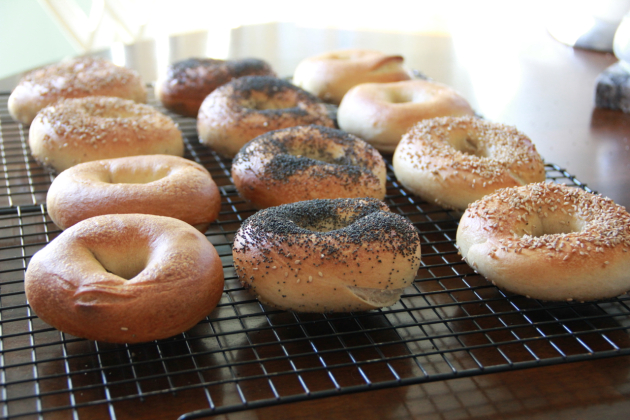A traditional New York style bagel recipe using wild sourdough for a unique and delicious flavor.
NY Style Bagels
Peter Reinhart’s NY Style Bagels are a testament to the art of bagel making. Using wild sourdough as a base, these bagels are a delicious blend of tradition and innovation. The process may be a bit lengthy, but the end result is well worth the effort. Enjoy these bagels in the traditional plain, poppy, sesame, salt or onion flavors.
Ingredients
Wild Sourdough Sponge: * 500 g bread flour * 500 ml non-chlorinated water * Your ripe 100% hydration wheat sourdough starter
Final Dough: * 1000 g of sourdough sponge * 4 cups bread flour, divided * 2 tsp barley malt or 1 tbsp malt barley syrup * 3 tsp salt * 1 tsp dry yeast
Directions
- Make the sponge: Mix whatever quantity of wheat starter you have with the water. Whisk until foamy. Add flour. Mix thoroughly until all lumps are gone. Cover loosely and leave for at least 6-8 hours. Sponge is ready when very foamy and stretchy, and when 1 tsp of starter dunked in a glass of cold water doesn’t sink.
- Make the dough: Measure out 5 cups of the starter sponge. Combine starter, salt, malt, yeast and 3 cups of flour in a bowl and mix together until they form a ball.
- Adding the remaining flour in batches, continue kneading the dough until all added flour is fully absorbed. Keep adding flour until the dough is tough and non-sticky, but still smooth and elastic.
- Continue kneading the dough until it’s fully smooth and elastic. It will still be quite tough. It will take about 10 minutes by hook or 15 minutes by hand to get to that stage.
- Immediately divide the dough into 12 (or 24) equal parts. Standard size bagel will be about 4-1/2 oz (130 g) when raw.
- Shape each portion of the dough into a ball, and then shape it into a roll, much like a bratwurst sausage.
- Cover all rolls with a damp towel and let them rest and relax for 20 minutes.
- Line a baking sheet or a board with parchment.
- Shape the bagels: Wrap each roll around your fingers, overlapping the ends right under your index finger.
- Press the ends together with your thumb and index finger, place your open palm with dough on it onto the table and roll back and forth a few times, allowing the ends to fuse together.
- Place the bagels as you shape them on the lined baking sheet or board. Cover with plastic and let rise 20 minutes.
- After 20 minutes, perform the float test. If the bagel floats within a few seconds, it’s ready. If not, return it under the plastic for another 15-20 minutes. Repeat the test.
- Once bagels are ready, place them, still covered with plastic, in the refrigerator and leave overnight or up to 36 hours.
- Boiling and baking: once you are ready to bake your bagels, preheat the oven to 500F. Prepare a board or a tray lined with a clean and dry dish towel for wet bagels to rest on. Line up your bagel toppings at this time.
- Place a wide pot filled with water on a stove and bring to a boil. Once the water is boiling rapidly, add 1 tbsp of baking soda to the pot, to increase the boiling. Leave the heat on high to ensure rapid boil at all times.
- Remove bagels from the fridge and carefully lower them 3-4 at a time into the boiling pot. Boil bagels for 1 minute on each side, turning them once.
- Remove bagels from the pot and line them up on the towel. Sprinkle bagels with toppings now, as they are the stickiest at this point. Proceed with the remaining bagels, until all of them are done and sprinkled.
- Transfer bagels onto the parchment lined baking sheet.
- Bake for 20-25 minutes, or until they are evenly browned on all sides. Some ovens are not baking evenly, so you will have to watch for that, and rotate the baking sheet mid-baking.
- Cool bagels on rack until manageable and enjoy. Allow bagels to cool fully before storing them in plastic.
- Bagels can be frozen after step 14 (overnight ripening in the fridge) or after they are fully baked and cooled. If you are baking bagels after freezing them, thaw bagels for 1 hour prior to boiling them.
- Good Bagels are One of the Tastiest Baked Treats you could ask for. Repeat: good bagels. And while most people don’t often have access to really well-made bagels, when we have them, we tend to remember both the bagels and where we got them. Like most baked goods, bagels have a few needs in their production, and they require a little special equipment, but there is nothing out of the ordinary, and nothing that is cost prohibitive.

